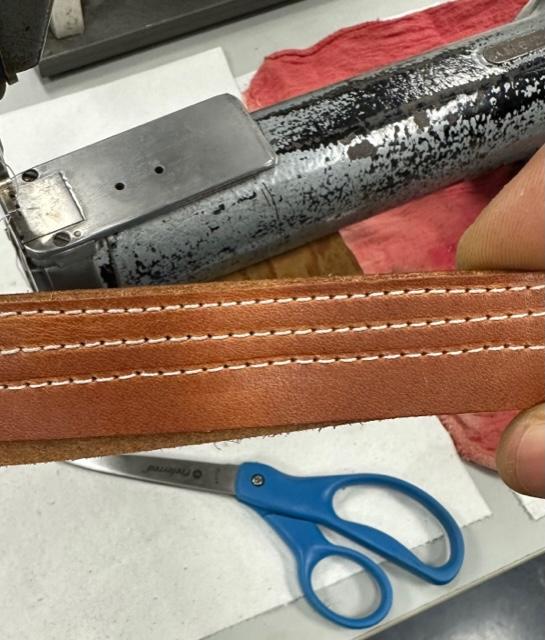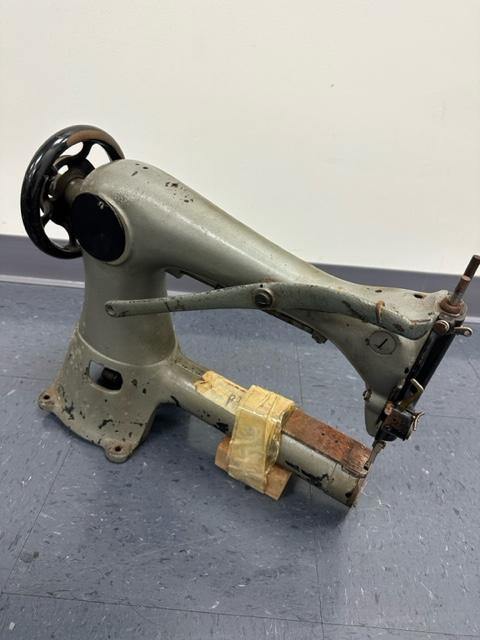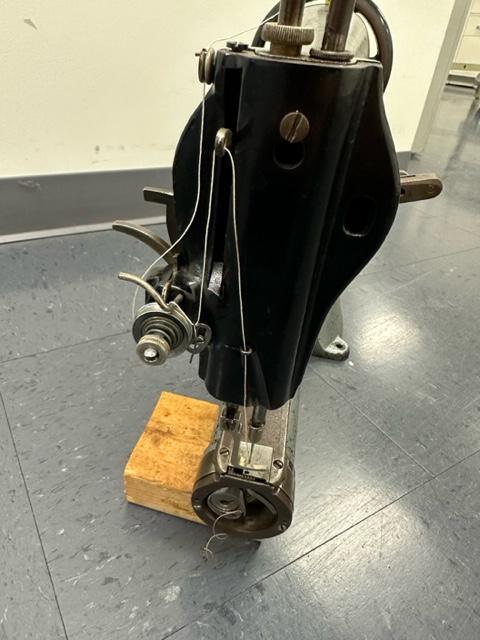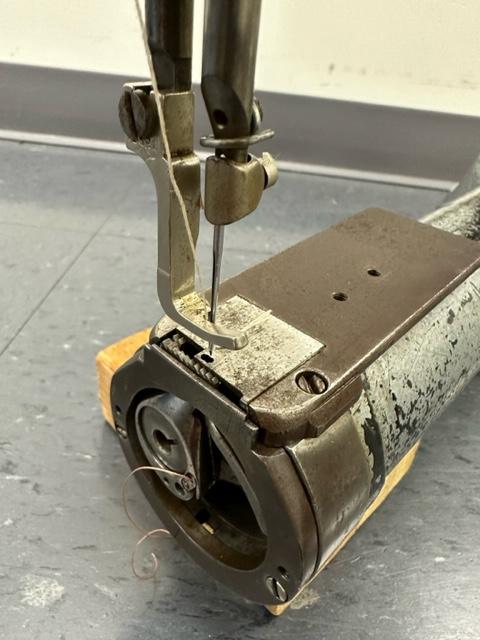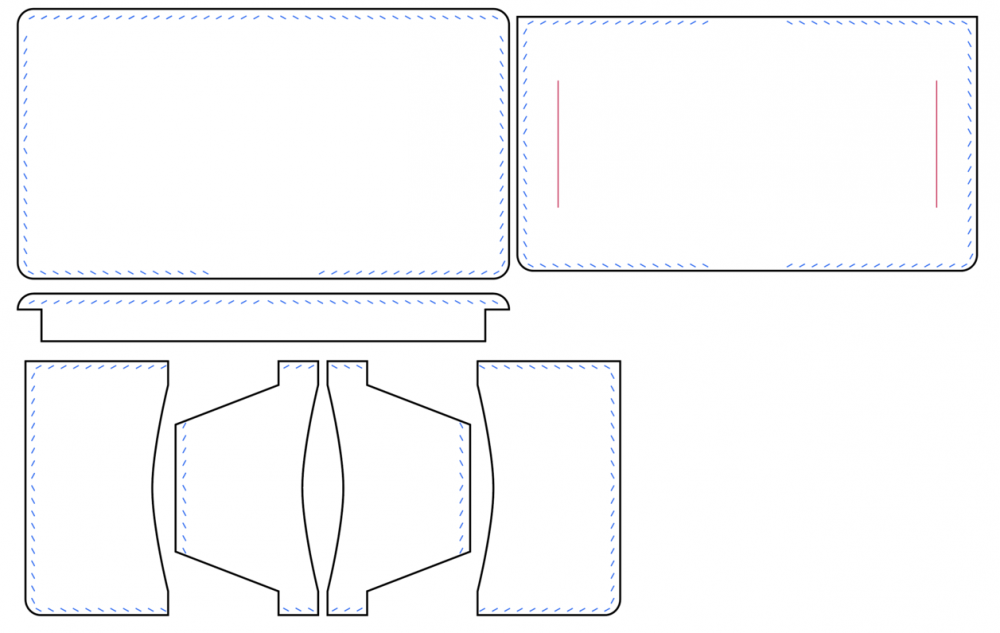
Webicons
Members-
Posts
250 -
Joined
-
Last visited
Content Type
Profiles
Forums
Events
Blogs
Gallery
Everything posted by Webicons
-
Singer 17-41 / presser foot swap = headache
Webicons replied to Webicons's topic in Leather Sewing Machines
Many thanks Contabulary! I think I’ve figured out a work around that won’t interfere with normal operations. Will post for posterity if it works out. -
Singer 17-41 / presser foot swap = headache
Webicons replied to Webicons's topic in Leather Sewing Machines
Thanks Wiz - This wheel also has the adjustment screw and spring. The problem is that it moves around too much. I’m going to see if I can’t engineer a fix. Thanks for the insight. Thanks Constabulary - I’ve been looking into that but I am a little hesitant because I don’t know what I’m doing and I don’t want to make a mess of it! Can you recommend any videos? Will research some more. As always, thanks for your responses! -
Singer 17-41 / presser foot swap = headache
Webicons replied to Webicons's topic in Leather Sewing Machines
In most cases the stitching only skips occasionally with the roller foot on but I found that it happens very frequently when the wheel isn’t pushed in towards the needle all the way (to the point where it is scrapping the thread guide). The wheel also moves out of proper alignment when I turn the leather sharply. This leads to the missed stitches. I could braze the wheel in place which would solve the movement issue but would be an inconvenience. I may just go back to the toe presser foot. It was sewing perfectly. Any ideas would be appreciated! (I had to edit the video down) IMG_1032.mov -
Singer 17-41 / presser foot swap = headache
Webicons replied to Webicons's topic in Leather Sewing Machines
Thank you. Great idea. Will take it tonight! -
So the honeymoon phase with the Singer 17-41 is over and the pull my hair out phase has just begun. The trouble started right after I changed the original narrow presser foot to a large roller foot to use in shoemaking. I adjusted the roller, raised up the presser shaft and readjusted the tension. The problem now is that the thread is getting jammed and cut up in the bobbin case assembly. The top thread sets temporarily and then pulls out. Eventually I have a birds nest in the assembly. Is there some other adjustment that needs to be made? On a different note; Is the thread supposed to have tension through the full motion of the take up lever ? On my unit, the thread gets slack when the lever is on its way down. Is this correct? Thanks for your help and patience!
-
Move along and save or maybe take a risk
Webicons replied to Webicons's topic in Leather Sewing Machines
I have to say how convenient it is to have a sewing machine now! After the learning curve (that I’m still going through), a machine just opens up a world of possibilities. Was going to toss a heavy duty tie down strap that the stitching was coming undone. It wouldn’t be worth my time to hand sew but with this light duty machine, it made quick work of it. Definitely going to fix up the second machine and maybe use it for canvas work by making a small top rest. Thanks for the help everyone! -
Move along and save or maybe take a risk
Webicons replied to Webicons's topic in Leather Sewing Machines
Yes. The more I work with it, the more I appreciate the patina. I’m just going to brighten up the rusted spots and call it a day. On a different note, I am working on dialing in the stitching. Frontside stitches are nice but the backside is questionable. From the pictures, is this the best that I can get or do I have a lot to learn! -
Singer 17-41 / fixing it up with a donor 17-16
Webicons replied to Webicons's topic in Leather Sewing Machines
Thank you. I appreciate the insight. It looked like someone has tried to take it off and mangled it in the process. I’m trying to figure out the tension to fix the backside stitches. Top looks beautiful but the bottom not so much. According to the manual the needle tension is too loose but as I tighten it the sewing action gets tough. Can you recommend some things I should look at? -
Move along and save or maybe take a risk
Webicons replied to Webicons's topic in Leather Sewing Machines
Oh. And here’s the donor 17-16. I took off a couple of pieces and put them on the 17-41. Not sure if I will fix it or not. -
Move along and save or maybe take a risk
Webicons replied to Webicons's topic in Leather Sewing Machines
Here are some pictures. Now that I pretty much know that it works (more or less) I’m going to start the disassembly process so I can properly clean and repaint the machine. Apart from wanting to change the presser foot to a roller foot, I believe that i might be missing some part of the tensioner, a nut for the reverse function and a latch that holds onto the tensioner is broken (not sure if I need it). I’ll be machining that piece though. Thanks again for the support and information! -
First I want to thank everyone who has helped me out with my first trip down the sewing machine rabbit hole. I had purchased a 17-41 in rough shape and I’m using a 17-16 as a donor unit to fix it up. Can someone tell me how to remove the tensioner “sleeve” from the cover (see pic). Was it originally heat pressed? Doesn’t want to budge. Thanks!
-
Move along and save or maybe take a risk
Webicons replied to Webicons's topic in Leather Sewing Machines
So after a bunch of frustration dealing with Facebook Marketplace I finally picked up a machine (well two) for $150. One is a Singer 17-41 and the other a 17-16. The 17-41 seems to work ok while the 17-16 might need some work. They both are eyesores as rust has started creep in but the plan is to clean them up as best I can and cannibalize the 17-16 if I need it. Since I will primarily be using it for shoe uppers I will need to replace the presser foot with a roller. It seem that I will also need to replace the throat plate (flat) with one that will work with a roller? Does this also mean I need to replace the dogs as well? Is anyone familiar with this process? Can someone direct me to a source for both parts and advice? Again, thank you for your kind assistance to this point. -
Move along and save or maybe take a risk
Webicons replied to Webicons's topic in Leather Sewing Machines
-
Hello Folks - continuing my journey to find a sewing machine as the deal I was working on fell through. So now I am looking at a Seiko CH-8B with specifications that are perfect for some items that I make (belts, wallets, binder and covers) but overkill for the purpose that I am actually considering purchasing a machine for (shoe uppers). Questions: being that the CH is overpowered for the relatively thin leathers of shoe uppers, will it still do an adequate job or is there some drawback? The CH will handle the beautifully thick threads but can I handle the thin as easily? The specifications states the maximum stitch length but not the minimum. Is it infinity adjustable down from the max? Can I purchase a roller foot for the Seiko CH-8B? I have a feeling that there is no one machine that is “perfect” for everything and that’s why machine users are notorious for buying tons of machines! What I am looking for is a good all around machine with a slight tilt towards shoe/sneaker uppers. Thanks!
-
Move along and save or maybe take a risk
Webicons replied to Webicons's topic in Leather Sewing Machines
I am going to look at the machine on Wednesday. The seller does not know anything about it nor has he ever used it. Is there anything I should be extra cautious about checking out? Any deal breaking conditions I should look out for? Most that I can do at this point is to eyeball the unit and make sure nothing’s cracked or obviously visually wrong (or maybe missing) . Are seriously worn dogs a no go or can it be fixed? Thanks again! -
Move along and save or maybe take a risk
Webicons replied to Webicons's topic in Leather Sewing Machines
Thank you for everyone’s response! I knew that I could count on the knowledge base here, especially when it comes to sewing machines! It definitely seems like a Singer 17-X and it’s comforting to know that the Seiko clone parts might fit. I’m going to give it a go. If nothing look’s especially mangled then it seems that a few hundred would be worth the risk. I read some past posts about the 17 series and how a small amount of movement on the bottom feed may indicate a shot machine but hopefully it’s something that can be fixed. I am a fairly handy guy doing a fair bit of my own machining and machinery repairs but when it comes to sewing machines I blank out looking at the innards. More like a watch movement than anything I'm comfortable working on. Hopefully I can learn on this unit and not bungle it up too much. -
Hello Folks, So I’ve been away for quite some time from leatherworking but the bug bit me again and this time I would like to explore shoe making in more depth than I have. I found this unit near me. The owner hasn’t responded with the model number but I wanted to get your take on it and I am positive that someone here can identify it. The asking price is a few hundred but am I throwing money at a paperweight? My usual response is to save up and don’t buy someone else’s headache but sewing machines are a bit daunting. I would like to ease into it. I figure I can cobble together a brushless motor and speed reducer for this one (or even just hand spin) but are parts available and can a typical repair shop even service it? As always, thanks for the advice! - Ed
-
Looks like Chicago, IL.
-
A better quality hand splitter/skiver for soft leather
Webicons replied to DrmCa's topic in Leather Tools
When it comes to Japanese-type skiving knives you typically have three choices: unknown or common tool steel, shirogami, and aogami. Prices go up in that order and quality (edge retention) as well. When you do a little research on this you find that the rabbit hole goes deep. -
A better quality hand splitter/skiver for soft leather
Webicons replied to DrmCa's topic in Leather Tools
Before I got my bell skiver I was using a Japanese curved hand plane such as this one. I still use it for smaller pieces like wallet pockets and edges. The curve is key as you can easily adjust the cut by rocking without adjusting the blade. -
A nice selection of used sewing, skiving and cutting machines located in Cambridge, Ontario. Careful about the buyers premium and loading charges and always take a look in person if possible. From experience, I would not encourage those of us on the south of the border to bid on this auction as customs duties, taxes and documentation are a hassle. Real sweet Myford lathe there too! https://www.bidspotter.com/en-us/auction-catalogues/timed/bscdslin/catalogue-id-danbur10104
-
Yes. Interfacing can be used to stiffen up leather. I like to glue it on rather than apply heat. It seems to work better and no chance of scorching the leather.
-
Wallet fail, need advice
Webicons replied to sandmanred's topic in Purses, Wallets, Belts and Miscellaneous Pocket Items
It looks like you’re using full width card pockets. You can get away with “triangles” and reduce the edge thickness by a 1/3. On this template you can see what I mean about the card pockets. -
Stitching hole placement for rows of pockets
Webicons replied to JeremyG's topic in How Do I Do That?
Instead of punching a solid line across the pockets run the stitch line and stop X mm before the edge of the first pocket and then start your stitch line again on the next pocket. The stitching will have a small discrepancy where the pockets are but shouldn’t be too noticeable if you space things right.- 2 replies
-
- wallets
- pricking irons
-
(and 2 more)
Tagged with:
-
Which vendor did you end up purchasing from? Did they confirm that the tannery is Haas? Please post a photo and comment on the product and vendor. Thinking about purchasing more. Thanks


